

Cairo Tutorial for Python Programmers. By Michael Urman Cairo is a powerful 2d graphics library. This document introduces you to how cairo works and many of the functions you will use to create the graphic experience you desire. In order to follow along on your computer, you need the following things: Cairo itself,Python to run the code snippets, andPyCairo to join the previous two. Alternately, if you're up for a challenge, you can translate the examples to your preferred language and host environment and only need cairo from above.
Note: All the example code has a dependency on cairo 1.2.0 or higher for cairo.SVGSurface. Translations: fr. Table of Contents In order to explain the operations used by cairo, we first delve into a model of how cairo models drawing. If you find the descriptions below to be too sparse, Donn Ingle has created at-a-glance overview diagrams in SVG which try to tie everything together. Nouns Cairo's nouns are somewhat abstract. Destination The destination is the surface on which you're drawing. Source. L-System. Un article de Wikipédia, l'encyclopédie libre.
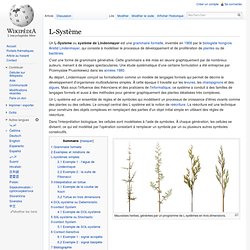
Un L-Système ou système de Lindenmayer est une grammaire formelle, inventée en 1968 par le biologiste hongrois Aristid Lindenmayer, qui consiste à modéliser le processus de développement et de prolifération de plantes ou de bactéries. C'est une forme de grammaire générative. Cette grammaire a été mise en œuvre graphiquement par de nombreux auteurs, menant à de images spectaculaires. Une étude systématique d'une certaine formulation a été entreprise par Przemyslaw Prusinkiewicz dans les années 1980. Au départ, Lindenmayer conçoit sa formalisation comme un modèle de langages formels qui permet de décrire le développement d'organismes multicellulaires simples.
Dans l'interprétation biologique, les cellules sont modélisées à l'aide de symboles. Mauvaises herbes, générées par un programme de L-systèmes en trois dimensions. Grammaire formelle[modifier | modifier le code] Un L-système est une grammaire formelle qui comprend : Hello World in pycairo « Heuristic Andrew. Cairo Tutorial. This tutorial is derived from Michael Urman's cairo tutorial for python programmers.
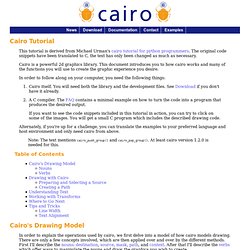
The original code snippets have been translated to C, the text has only been changed as much as necessary. Cairo is a powerful 2d graphics library. This document introduces you to how cairo works and many of the functions you will use to create the graphic experience you desire. In order to follow along on your computer, you need the following things: Cairo itself. Alternately, if you're up for a challenge, you can translate the examples to your preferred language and host environment and only need cairo from above. Note: The text mentions cairo_push_group() and cairo_pop_group(). Table of Contents In order to explain the operations used by cairo, we first delve into a model of how cairo models drawing. Nouns. Pycairo Documentation — Pycairo v1.10.0 documentation.
Installing igraph — python-igraph v0.6 documentation. This chapter describes how to install the C core of igraph and its Python bindings on various operating systems.
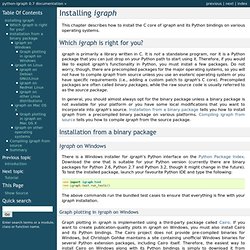
Which igraph is right for you? Igraph is primarily a library written in C. It is not a standalone program, nor it is a Python package that you can just drop on your Python path to start using it. Therefore, if you would like to exploit igraph‘s functionality in Python, you must install a few packages. Do not worry, though, there are precompiled packages for the major operating systems, so you will not have to compile igraph from source unless you use an esoteric operating system or you have specific requirements (i.e., adding a custom patch to igraph‘s C core). In general, you should almost always opt for the binary package unless a binary package is not available for your platform or you have some local modifications that you want to incorporate into igraph‘s source.
Pycairo. Pycairo is a set of Python bindings for the cairo graphics library.
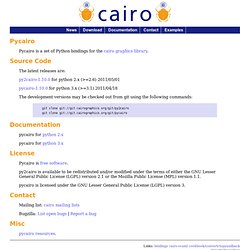
The latest releases are: py2cairo-1.10.0 for python 2.x (>=2.6) 2011/05/01. Python Imaging Library Handbook. Python Image Manipulation. Exclusive offer: get 50% off this eBook here Python Multimedia — Save 50% Learn how to develop Multimedia applications using Python with this practical step-by-step guide by Ninad Sathaye | August 2010 | Beginner's Guides Web Development Web Graphics & Video In this article by Ninad Sathaye, author of Python Multimedia Beginner's Guide, explains basic image conversion and manipulation techniques using the Python Imaging Library.
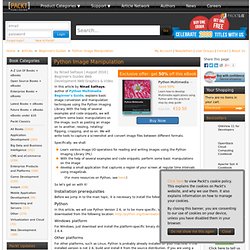
With the help of several examples and code snippets, we will perform some basic manipulations on the image, such as pasting an image on to another, resizing, rotating/ flipping, cropping, and so on. Specifically, we shall: Learn various image I/O operations for reading and writing images using the Python Imaging Library (PIL)With the help of several examples and code snippets, perform some basic manipulations on the imagedevelop a small application that captures a region of your screen at regular time intervals using ImageGrab.
Install Python Imaging Library (PIL) on Cygwin. I’ve just managed to get Django up and running on Cygwin.
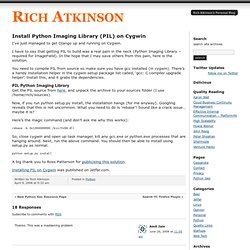
I have to say that getting PIL to build was a real pain in the neck (Python Imaging Library – required for ImageField). In the hope that I may save others from this pain, here is the solution. You need to compile PIL from source so make sure you have gcc installed (in cygwin). There’s a handy installation helper in the cygwin setup package list called, ‘gcc: C compiler upgrade helper’. Install this, and it grabs the dependencies. PIL Python Imaging Library Get the PIL source from here, and unpack the archive to your sources folder (I use /home/rich/sources).
Now, if you run python setup.py install, the installation hangs (for me anyway). Here’s the magic command (and don’t ask me why this works): Python Imaging Library PIL. Mise à jour: 25 juin 2009Version: 1.0Author: Jean-Louis Bicquelet-Salaün Location: (c) 2009 Jean-Louis BICQUELET-SALAÜN FAQ Revised: Friday 26 June 2009 18:17:03 Table of Contents.
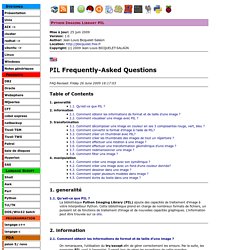
Pil-handbook.pdf (Objet application/pdf)